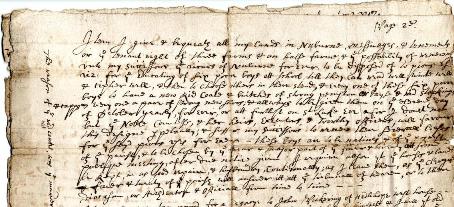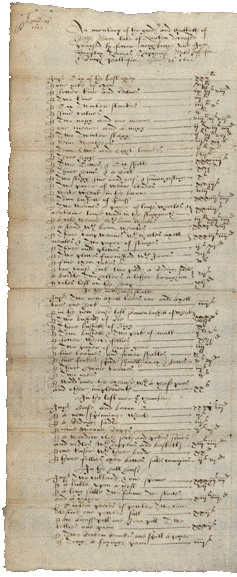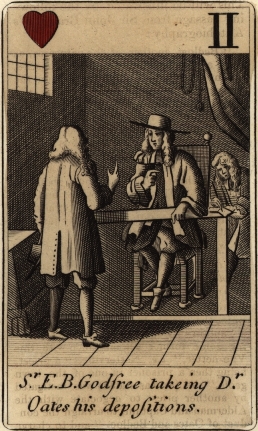 |
Memorandum That <in some one of> the months <in> the yeare of
<our lord 1644> Randall Fenwick late of Lampton
in the County of Durham gentleman, beinge wounded in his Majesties
service at Hessam alias long Maston moore, in the Countye
of Yorke but of good and perfect memorye, and haveinge
a firme and setled resolucion to make his will (as was
conceived) did at the Cittie of Yorke in the presente sight
and heareinge of Margaret Stevenson now wiefe of
William Hugill and of Margerie Billopp wiefe of John
Billopp nuncupatively and
by word of mouth declare his mind and meaneinge and
make his last will in wordes followeinge or in other wordes
tendinge to the like effect videlicet The sayd Randall Fenwicke
after he had made mencion of diverse debtes and summes of
money which were owen unto him conteyned in a note which
he then had in his handes and of other debtes likewise owen
unto him, and not conteyned in the same note did give and
bequeath aswell all the sayd debtes and summes of money
as all other his goodes and Chattels whatsoever unto his
brother Robert Fenwicke and did wish and desire the
sayd Margaret Stevenson to deliver unto his sayd
brother all such money and writeings and other thinges
as did any way concerne the sayd Randall Fenwicke
and were at that tyme in her custodye.
[End of page 1 of 1. Ref: DPRI/1/1647/F5/1-2]
Glossary
  Previous page Previous page
|
 |
Page 2d
…
Item I give & bequeath all my lands in Nuburne, Messuages, & tenements
or the tenant right of three farms & an halfe farme; & the possability of revercion
unto my successors, the vicars of Nuburne for ever, to be disposed of to pious us[es]
videlicet for the educating of six poor boys att school till they can read well, write well
& cipher well, & then to choose others in there stead, & every one of these six poore
boys to have a new Rid Coate & britches of strong peniston or bayse & rid stockings
& capps & every one a parr of strong new shoos; & allways to be given them on the eleventh day
of October yearly, for ever, or att furthest on St Luke Eve for I doubt not
but the Noble Countesse, & her heirs, Executors, & worthy officers; will favour
this designe perpetually; & suffer my successors to renew there severall leases
for the sayd pious uses for ever - these boys are to be natives & of the poorest
of the parish, & to be chosen by the vicar & major part of the fouer & twenty att some
publique meeting, after due notice given; I require allsoe that the houses & lands
be kept in as good repaire, & husbandry, Continually; as I leave them, as the Clergy
& fouer & twenty of the parish will answer itt; att the tribunall of heaven, or to there
diocasan, or Archdeacon & Official from time to time …
[marginal note:]
The reason of the rid coates, was the murder of Sir Edmund Godfrey, the 12th October, whose Blood which others designed, I would have remembered against the papysts.
[End of page 1 of 1. Ref: DPRI/1/1683/D9/1]
Glossary
| bayse [baize] |
a coarse woollen stuff, having a long nap, now used chiefly for linings, coverings, curtains, etc., in warmer countries for articles of clothing, e.g. shirts, petticoats, ponchos; it was formerly, when made of finer and lighter texture, used as a clothing material in Britain also |
| cipher |
to use the Arabic numerals in the processes of arithmetic; to work the elementary rules of arithmetic |
| Noble Countesse |
the Countess of Northumberland, widow of the Earl of Northumberland, the lord of the manor of Newburn |
| papysts [papists] |
Roman Catholics (derogatory) |
| peniston |
a kind of coarse woollen cloth used for garments, linings, etc. |
| St Luke Eve |
the eve of the feast-day of St Luke, i.e. the day before 18th October |
| videlicet |
namely |
  Previous page Previous page
|
 |
Aprill 23o
1622
An inventory of the goodes, and Chattelles of
George Mann late of Norton deceased
praysed by fower neighboures. videlicet John
Harperlay, Thomas Chipchaise, Myles Jefferson
& Raiph Patteson. April 23o. 1622.
| Inprimis Six of the best oxen |
xxii li |
|
|
| Item one yoke of oxen |
vi li |
|
|
| Item fower kine and calves |
ix li |
vi s |
viii d |
| Item Two kine |
iii li |
|
|
| Item Six Twinter sturkes |
iiii li |
v s |
|
| Item five calves |
ii li |
|
|
| Item Two nagges and one meare |
viii li |
vi s |
viii d |
| Item one meare and a nagg |
ii li |
xiii s |
iiii d |
| Item Two Twinter stagges |
ii li |
vi s |
viii d |
| Item Neine weathers |
iii li |
xii s |
|
| Item Tenn Ewes and Eight lambes |
ii li |
x s |
|
| Item Three hogges |
|
vi s |
|
| Item Two Sowes & Six shottes |
|
xxxiiii s |
|
| Item Three henns & a Cock |
|
|
xvi d |
| Item Two stegges, five brod geese & seaven geslinges |
|
x s |
|
| Item Two payer of weane blades |
|
xviii s |
|
| Item white wheat in the barne |
viii li |
|
|
| Item Tenn bushelles of peass |
|
xxxiii s |
iiii d |
Item Two weanes, a payer of louse wheeles &
certaine louse wood in the staggarth |
|
xxiiii s |
|
| Item a cole weane with bonn wheeles |
iii li |
xiii s |
iiii d |
| Item a slead with bonn wheeles |
|
xxvi s |
viii d |
Item Three coup weanes with wheeles, axell
neales & Two payer of stinges |
|
xxxiii s |
iiii d |
| Item Three ould plowes |
|
ii s |
vi d |
| Item Two plowes furnished with Irons |
|
vi s |
|
| Item five oxen yokes |
|
v s |
|
Item one horse heck two paddes, a Ridinge sadle
a bridle, Two helters, a lether braughan |
|
vi s |
|
| Item coles left on the heap |
|
|
xii d |
In the new house stable |
|
|
|
Inprimis Two new axell trees, one ould axell
tree, one heck |
|
iiii s |
|
| Item in the new house loft, seaven bushell of wheat |
|
xxxv s |
|
| Item Two bushelles of Rie |
|
viii s |
|
| Item Three bushelles of Bigg |
|
x s |
|
| Item Tenn bushelles & Two peckes of malt |
ii li |
v s |
|
| Item fower wheele fellies |
|
|
xvi d |
| Item Two payer of horse gear |
|
iiii s |
|
| Item five teames, and fower shakles |
|
x s |
|
| Item five forkes, spades, shovelles, an ax, & fowes |
|
v s |
vi d |
| Item Three Swine trowes |
|
iii s |
|
| Item Two yokes |
|
ii s |
|
Item Wodd over the oxhouse with a cheese pres
and other implementes |
|
xx s |
|
In the loft over the chamber |
|
|
|
| Inprimis Beefe and bacon |
|
xxvi s |
viii d |
| Item a new spinninge wheele |
|
ii s |
|
| Item a Ridinge sadle |
|
iii s |
|
| Item five weane Ropes |
|
ii s |
vi d |
Item a window cloth, seckes and pokes, seves
and ridles with hoppers and baskettes |
|
xiii s |
iiii d |
| Item one kaser, with three bordes |
|
|
xx d |
| Item three fellies, oxen bowes, sales, crampins |
|
ii s |
vi d |
In the hall house |
|
|
|
| Item Two cubbardes, & one spence |
|
xxxiii s |
iiii d |
| Item a table upon a chest |
|
vii s |
|
Item a long settle, Two formes, Two stooles
and a chayer |
|
xiii s |
iiii d |
Item Sixtein peeces of pewter Two can-
dlestickes one pewter salt |
|
xxii s |
|
Item one brass pott, one Iron pott, Two
kettles, one pann |
|
xxvii s |
|
Item Two Recken Crookes, one spitt a payer
of Tonges, a fryinge pann |
|
iiii s |
|
[End of page 1 of 1. Ref: DPRI/1/1622/M1/3]
Glossary
| Bigg |
a hardy variety of barley grown mainly in northern England and Scotland |
| boun wheeles |
bound [?] wheels: perhaps meaning iron-bound wheels |
| bushel |
a measure of capacity containing four pecks or eight gallons |
| coup weane |
a wagon with closed sides and ends, thus fitted for carting dung, lime, etc. |
| crampin [crampon] |
a bar of iron or other metal bent in the form of a hook, to serve as a grapple or clutch; a grappling-iron |
| fellies |
the curved pieces of wood which, joined together, form the circular rim of a wheel |
| fowes |
unknown [?hoes] |
| heck |
a rack made with parallel spars to hold fodder, either fixed in a stable, or movable, so as to be placed in a field, cattle-yard, or sheep-fold |
| hogges |
young sheep from the time they cease to be lambs until their first shearing |
| kaser [caser] |
unknown |
| kine |
cows |
| meare |
mare |
| nagg [nag] |
a small riding-horse or pony |
| oxen bowes |
oxen yokes |
| peck |
a unit of capacity for dry goods equal to a quarter of a bushel, now equivalent (in Britain) to two imperial gallons (approx. 9.09 litres) or (in the U.S.) to eight quarts (approx. 8.81 litres) |
| pewter salt |
a salt-cellar made of pewter |
| Recken Crookes |
pot hangers |
| Rie |
Rye |
| sales |
ropes for tying up cattle |
| settle |
seat |
| seve |
sieve |
| shottes |
in this instance, weaned pigs; also used to describe ill-grown ewes, the refuse animals left after the best of the flock or herd have been selected |
| slead [sled] |
a drag used for the transport of heavy goods, etc. |
| spence |
cupboard |
staggarth
[stack-garth] |
a stack-yard, rick-yard |
| stegges |
ganders, or male geese |
| stinges |
poles, staffs |
| team |
part of the gear by which oxen or horses were harnessed to a plough, harrow, or wain. In modern dialect use, a chain to which oxen are yoked in lieu of a pole; in plough equipment, the main or leading chain, by which the whole of the oxen or horses drag the implement |
| trowes |
troughs |
| Twinter stagges |
young two-year-old horses |
| Twinter sturkes |
young bullocks or heifers, two winters in age, i.e. two years old |
| weanes |
wagons |
weane blades
[wain-blades] |
wain (wagon) shaft |
| weathers |
a male sheep, a ram; especially a castrated ram |
| white wheat |
wheat with white or light-coloured grain |
  Previous page Previous page
|



![Click to zoom Image of the Will of William Angas of Rawhouse [?Roe House] in Bywell St Peter, yeoman. Ref: DPRI/1/1637/A6/1-2](images/DPRI-1-1637-A6-1_small.jpg)


